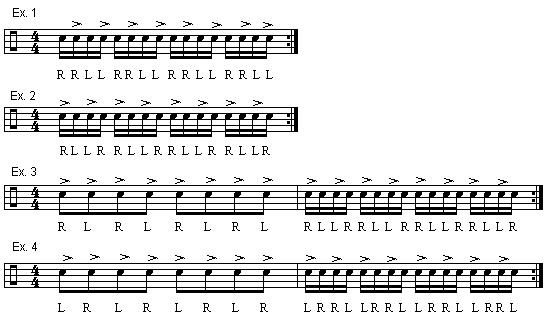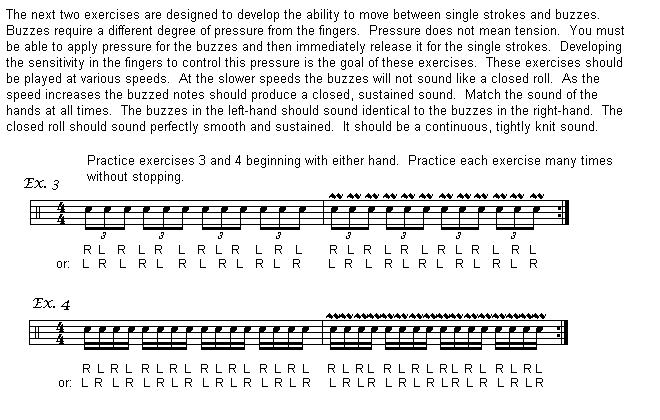
While visiting various drumset forums I have noticed that many questions will crop up
repeatedly. In this FAQ section I have attempted to collect some answers to a few of these
questions. I hope that by organizing these questions and answers into a FAQ document I can
create more informative and thoughtful answers. The responses found here are certainly not
definitive. They are just my thoughts on some commonly asked questions.
Contents
How do I improve my double stroke roll?
The double stroke is an extremely important and useful part of any drummer's vocabulary.
The ability to execute clean doubles can greatly enhance your playing. In order to make
doubles sound as clean and even as possible, it is necessary that each stroke be played
with the same amount of force or power. In other words, the main stroke and the subsequent
rebound should be of the same volume. In reality this will be impossible to completely
achieve. The second stroke of a double is a bounce, and by it's nature will be somewhat
softer than the initial stroke. This tendency can be largely overcome by focusing on the
second stroke of each double. By practicing doubles with an accent on the second stroke we
can develop control of the rebound and to a large extent make our double stroke rolls
sound (almost) perfect.
Here are a few examples.

Ex. 1 shows the double stroke roll with the accent on the second stroke. Ex. 2 shows
another sticking for the same exercise. By beginning the exercise with a single stroke we
displace the accents and make the exercise a little bit easier to feel. The accents now
fall on a strong pulse. Ex. 3 shows a combination of single strokes and doubles. Once
again the second stroke of each double is accented. Ex. 4 is the same exercise but
starting with the left hand.
These are just a few exercises to demonstrate the concept. For a more in depth treatment
of rebound control see George Lawrence Stone's two books, Stick Control and Accents
and Rebounds.
Back to Contents
How do I improve my closed (buzz)roll?
The closed, or buzz roll, is one of the most important techniques a drummer
can master. It is also perhaps the most difficult. The sound of the buzz roll
should be perfectly smooth, with no breaks or uneveness whatsoever. It should
be one continuous sound. Since the buzz roll is the technique by which a drummer
creates a sustained sound it should mimic the long tones produced by wind and
string instruments. Unfortunately drummers don't have the advantage of
sustaining a sound with the breath or drawn bow, so they must emulate a
sustained sound by use of the buzz roll. The following exercises are meant to
aid in the development of a smooth buzz roll. When practicing them keep
in mind that the ultimate goal is to produce a completely smooth and unbroken
sound.


The following MP3 contains a quick run through of the exercises described above.
In actual practice you should take a much longer time to complete each exercise.
Buzz Roll MP3
Back to Contents
Bass Drum Technique
Should I play "into" the bass drum
head?
A drum will always sound its best when tuned to its most resonant pitch and allowed to
vibrate freely. One way to get a drum to resonate freely is to get the striker, be it
stick or bass drum beater, off the head. This goes for snares, toms, and bass drums. With
a bass drum this resonance can sometimes be a problem. In a small group setting it may
make the drum sound to boomy and overpowering. That's why drummers started using felt
strips on their bass drum heads. With the advent of rock a more articulate sound was
desired so people started using pillows, blankets, etc. The problem with heavy muffling is
that it diminishes the volume of the drum. Leaving the beater against the head is also a
form of muffling. It prevents the head from vibrating, therefore diminishing its volume.
If you want to get a big sound out of a drum reduce the muffling and get the beater off
the head. I believe a well tuned 20" bass drum played with good technique, will have
a bigger sound than a heavily muffled 22" or 24". The trick is to use the
minimum of amount of dampening to get the desired sound. Different styles of music require
different levels of dampening. Most of the dampening can be achieved by a pre-muffled head
and/or one of those bass drum pillows made by Evans and DW. For most purposes the
dampening should not come from digging the beater into the head. That may be OK for an
occasional accent, but it shouldn't be the basis of your technique. Its not the way to get
a good sound or use the physics of the instrument to help you play. You wouldn't play toms
and snare by leaving the stick on the head. It doesn't sound good. It is also inneficient.
The same thing goes for the bass drum. If you dig the beater into the head every time you
want to make a stoke you need to first release it (because it's resting on the head). That
means additional work and delay before you can play the next stroke. Get in the habit of
playing "off" the head and you should notice an improved sound and more fluid
technique.
How tight should the spring tension on my
bass drum pedal be?
The bass drum it just another drum. The same physics apply to it as any other percussion
instrument. An insteresting thing to try, which I first saw suggested by Ed Soph, is to
completely disengage the spring on your bass drum pedal. Then try to play single strokes.
You may discover some inefficencies in your bass drum technique. The beater should rebound
from the head just like it does on the snare and toms. Try to not let the spring
compensate for poor technique. The spring is really just an aid to the natural rebound of
the beater. If you're playing with a fluid stroke the spring should not need to be very
tight. Start with a loose spring tension and then only tighten it to the point where the
pedal will respond as quickly as your foot. The pedal tension and the speed of your foot
should be in sync. Going beyond that point is overkill and will make your playing tense
and cause quicker fatique. The name of the game in all musical performance is relaxation.
Use common sense and examine the physics of what you are attempting to do.
Should I play the bass drum heel up or heel
down?
In one sense heel up is similar to using finger control. It's an aid to playing fast
groups of notes and therefore is a very useful technique to develop. When playing longer
groups of fast notes lifting the heel "slightly" (i.e. 1/4 to 1/2 inch) will
help keep the lower leg muscles relaxed. Also finding the "sweet" spot on the
pedal is important. It's usually about 3 to 4 inches from the very top of the pedal. Use
the ball of the foot, not the toes. For slower patterns you can leave the heel down or up.
Just remember to release the beater from the head. If you are concerned about volume when
playing heel down I will mention that several prominent players recommend a heel down
approach. A few being John "JR" Robinson, Billy Cobham, and Mike Baird. I refer
to these guys because they all play in high volume situations and the heel down approach
works perfectly well for them. As an experiment try recording your bass drum sound playing
both heel up and heel down. Don't have the drum heavily muffled. Make sure to release the
beater and use a full stoke when you are playing heel down. You may be pleasantly
surprised at the amount of volume you can produce with a heel down technique. One other
thing worth mentioning is throne position. Try moving your throne back a bit and sitting
toward the front edge of the throne. By moving the throne back your ankle should be in a
more relaxed postition than if you are are sitting very close to the bass drum.
Back to Contents
How should I count odd time signatures?
Odd time is generally considered time signatures other than the usual 4 beats, 3 beats, or
2 beats to a measure. In other words 4/4, 3/4, and 2/4 would NOT be considered odd time.
Time signatures with 5 beats, 7 beats, 11 beats, etc. to a measure ARE considered odd
time. This may serve as a general rule of thumb. Most Western music (i.e. music coming
from the European tradition) is played with 4, 3, or 2 beats (or counts) to a measure.
Anything else is unusual, or ODD. That's a simple definition of odd time.
As far as counting is concerned, odd time signatures can almost always be broken down
into smaller groupings of notes (usually groups of two's and three's). For example, 5/4 is
commonly felt and counted as a group of 3 quarter notes followed by a group of 2 quarter
notes. So you might count 123,12 123,12 etc.. It could also be reversed and counted
as 12,123 12,123 etc. It doesn't matter if it's written in 5/4, 5/8, or 5/16, the
principle is the same: feel and count the rhythm in groups of two's and three's. The
phrasing of the particular song will dictate whether you feel and count 12,123 or
123,12. A famous example of odd time is the tune Take Five, recorded by the Dave
Brubeck Quartet. It is played as 123,12. Listen to the tune and you can hear the
groupings of 3's and 2's. The same principle can be applied to other odd time signatures.
For example 7/8 might be counted as 123,12,12 or 12,12,123 or even 12,123,12.
11/16 might be counted as 12,12,123,12,12 or maybe as 123,123,123,12. The
important thing to remember is that the phrasing of the song dicatates how the groupings
of two's and three's are felt.
Some good listening for odd time signatures are recordings by the Don Ellis big band,
some Dave Brubeck recordings, the Mahavishnu Orchestra, and Frank Zappa. A good book is
Ralph Humphrey's text entitled Even in the Odds.
Back to Contents
Back to the main
page


